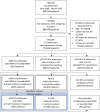New-onset atrial fibrillation in intensive care: epidemiology and outcomes
- PMID: 35792651
- PMCID: PMC9362765
- DOI: 10.1093/ehjacc/zuac080
New-onset atrial fibrillation in intensive care: epidemiology and outcomes
Abstract
Aims: New-onset atrial fibrillation (NOAF) is common in patients treated on an intensive care unit (ICU), but the long-term impacts on patient outcomes are unclear. We compared national hospital and long-term outcomes of patients who developed NOAF in ICU with those who did not, before and after adjusting for comorbidities and ICU admission factors.
Methods and results: Using the RISK-II database (Case Mix Programme national clinical audit of adult intensive care linked with Hospital Episode Statistics and mortality data), we conducted a retrospective cohort study of 4615 patients with NOAF and 27 690 matched controls admitted to 248 adult ICUs in England, from April 2009 to March 2016. We examined in-hospital mortality; hospital readmission with atrial fibrillation (AF), heart failure, and stroke up to 6 years post discharge; and mortality up to 8 years post discharge. Compared with controls, patients who developed NOAF in the ICU were at a higher risk of in-hospital mortality [unadjusted odds ratio (OR) 3.22, 95% confidence interval (CI) 3.02-3.44], only partially explained by patient demographics, comorbidities, and ICU admission factors (adjusted OR 1.50, 95% CI 1.38-1.63). They were also at a higher risk of subsequent hospitalization with AF [adjusted cause-specific hazard ratio (aCHR) 5.86, 95% CI 5.33-6.44], stroke (aCHR 1.47, 95% CI 1.12-1.93), and heart failure (aCHR 1.28, 95% CI 1.14-1.44) independent of pre-existing comorbidities.
Conclusion: Patients who develop NOAF during an ICU admission are at a higher risk of in-hospital death and readmissions to hospital with AF, heart failure, and stroke than those who do not.
Keywords: Atrial fibrillation; Cohort studies; Critical care; Epidemiology; Intensive care.
© The Author(s) 2022. Published by Oxford University Press on behalf of the European Society of Cardiology.
Conflict of interest statement
Conflict of interest: P.J.W. was Chief Medical Officer for Sensyne Health (Oxford, UK); has received grant funding from the National Institute for Health Research (NIHR), the Wellcome Trust and Sensyne Health outside the submitted work; and is supported by the NIHR Biomedical Research Centre, Oxford. J.P.B. is supported by an award to the University of Oxford, NIHR Doctoral Research Fellowship (grant number 300224). O.R. has received grant funding from NIHR and Sensyne Health outside the submitted work.
Figures




References
-
- Wetterslev M, Haase N, Hassager C, Belley-Cote EP, McIntyre WF, An Y, Shen J, Cavalcanti AB, Zampieri FG, Guimaraes HP, Granholm A, Perner A, Møller MH. New-onset atrial fibrillation in adult critically ill patients: a scoping review. Intensive Care Med 2019;45:928–938. 10.1007/s00134-019-05633-x - DOI - PubMed
-
- Klouwenberg PMK, Frencken JF, Kuipers S, Ong DS, Peelen LM, van Vught LA, Schultz MJ, van der Poll T, Bonten MJ, Cremer OL. Incidence, predictors, and outcomes of new-onset atrial fibrillation in critically ill patients with sepsis: a cohort study. Am J Respir Crit Care Med 2017;195:205–211. 10.1164/rccm.201603-0618OC - DOI - PubMed
MeSH terms
Grants and funding
LinkOut - more resources
Full Text Sources
Medical
Miscellaneous

